Numedal og Sandsvær | |
|---|---|
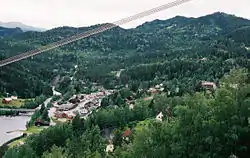 Rødberg, the largest settlement in Numedal. | |
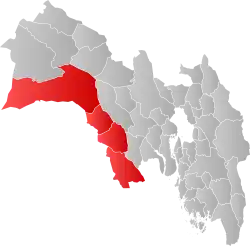 Map of Numedal with municipalities | |
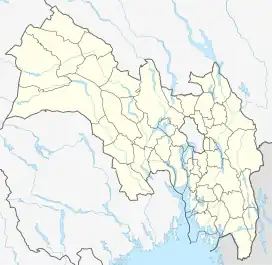 Numedal og Sandsvær 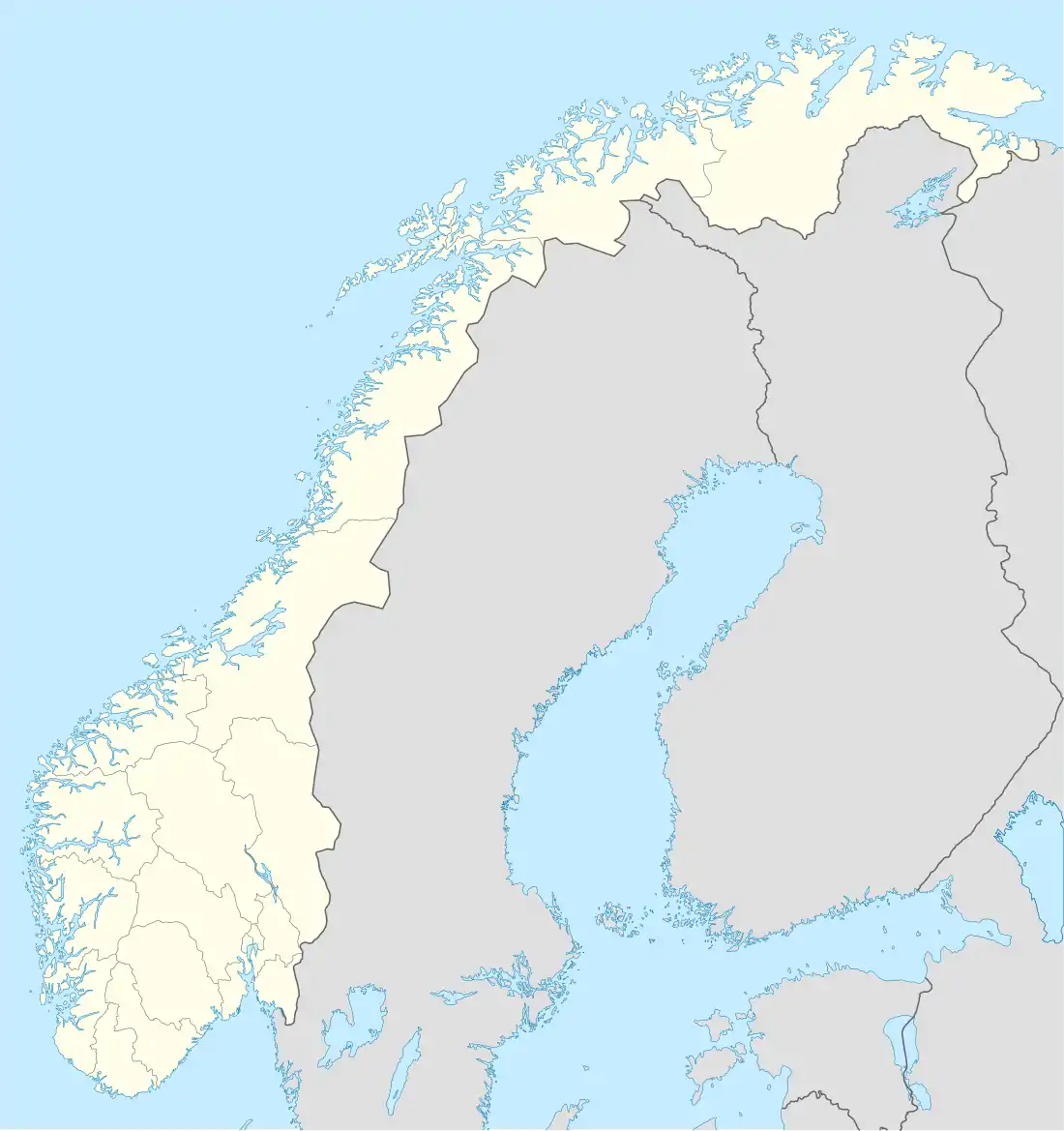 Numedal og Sandsvær | |
| Coordinates: 60°00′N 9°12′E / 60°N 9.2°E | |
| Country | Norway |
| County | Viken |
| Region | Austlandet |
| Adm. Center | Rødberg[lower-alpha 1] |
| Area | |
| • Total | 3,513 km2 (1,356 sq mi) |
| Population (2014) | |
| • Total | 6,609 |
| • Density | 1.9/km2 (4.9/sq mi) |
| Demonym | Numedøl |
Numedal (Norwegian: [ˈnʉ̀ːmədɑːɫ]) is a valley and a traditional district in Eastern Norway located within the county of Buskerud. It traditionally includes the municipalities Flesberg, Nore og Uvdal and Rollag. Administratively, it now also includes Kongsberg.[1][2]
Geography
Numedal is the southernmost valley of the major valleys in Eastern Norway. Numedal is largely a U-shaped valley. Most of the area is mountainous, especially west of the main valley, with steep valley sides. Running north–south, it extends between Flesberg in the south to Rødberg in the north, passing through the municipalities of Flesberg, Rollag and Nore og Uvdal. The Numedalslågen, the third-longest river in Norway, flows through the valley before discharging into Oslofjord at Larvik.
Transportation
National Road 40 runs from Larvik. National Road 7 crosses Hardangervidda to Geilo. Numedal Line Railway (Numedalsbanen) was opened in 1927 and stopped operations in 1988. The former railroad track from Veggli to Rødberg is now used principally for cycling.
Economy
Agriculture and forestry are important industries in the valley along with hydropower generation, as well as growing tourist traffic.[3][4][5]
Etymology
The name comes from Nauma, the Old Norse name for the Numedalslågen, and dal meaning "valley". The origin and meaning of the name are the same as that of Namdalen.[1][6]
Attractions

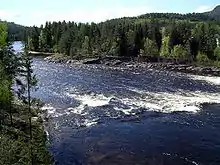
The area along the Numedalslågen from Flesberg up to the Hardangervidda through the valley has a large number of examples of Medieval Scandinavian architecture. There are still over 40 historic timber buildings and four stave churches: Flesberg Stave Church, Rollag Stave Church, Nore Stave Church and Uvdal Stave Church.[7][8]
Numedal was also the location of one of the "Nordmann's trails" (Nordmannsslepene), which were the old main roads between east and west over Hardangervidda. On the marked paths, remains of Stone Age dwelling places, bog iron works and grave mounds can be seen.[9][10]
Numedal also has several museums including Nore og Uvdal Open Air Museum (Nore og Uvdal Bygdetun) in Uvdal, Rollag Open Air Museum (Rollag Bygdetun) in Rollag, and Dåset Open Air Museum (Dåset bygdetun) at Flesberg. These are collections of historic buildings, mostly built in the traditional style common for the valley.[11][12][13]
Gallery
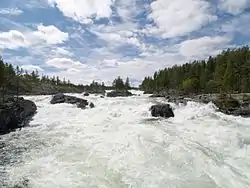 Godfarfossen on Numedalslågen
Godfarfossen on Numedalslågen Rødberg Station on the partially closed Numedal Rail Line
Rødberg Station on the partially closed Numedal Rail Line Rollag Stave Church
Rollag Stave Church Alfstadloftet
Alfstadloftet Bakkerud Station
Bakkerud Station Vrengja at Lågen
Vrengja at Lågen
Climate
Numedal has a subarctic climate (Dfc) with short, mild, and wet summers with cool nights and long, cold, and snowy winters.
| Climate data for Lyngdal in Numedal 1961–1990, extremes 1959–2015 | |||||||||||||
|---|---|---|---|---|---|---|---|---|---|---|---|---|---|
| Month | Jan | Feb | Mar | Apr | May | Jun | Jul | Aug | Sep | Oct | Nov | Dec | Year |
| Record high °C (°F) | 11.5 (52.7) |
12.5 (54.5) |
16.6 (61.9) |
24.2 (75.6) |
28.3 (82.9) |
32.6 (90.7) |
31.3 (88.3) |
32.2 (90.0) |
25.0 (77.0) |
24.0 (75.2) |
15.1 (59.2) |
13.4 (56.1) |
32.6 (90.7) |
| Mean daily maximum °C (°F) | −3.6 (25.5) |
−1.2 (29.8) |
3.3 (37.9) |
8.2 (46.8) |
14.7 (58.5) |
19.5 (67.1) |
20.5 (68.9) |
19.1 (66.4) |
14.0 (57.2) |
8.8 (47.8) |
1.5 (34.7) |
−2.3 (27.9) |
8.5 (47.4) |
| Mean daily minimum °C (°F) | −11.1 (12.0) |
−10.5 (13.1) |
−6.5 (20.3) |
−2.3 (27.9) |
2.9 (37.2) |
7.2 (45.0) |
8.9 (48.0) |
7.8 (46.0) |
4.3 (39.7) |
0.8 (33.4) |
−5.2 (22.6) |
−9.8 (14.4) |
−1.1 (30.0) |
| Record low °C (°F) | −34.2 (−29.6) |
−31.0 (−23.8) |
−27.3 (−17.1) |
−15.2 (4.6) |
−7.2 (19.0) |
−2.1 (28.2) |
0.5 (32.9) |
−0.5 (31.1) |
−5.6 (21.9) |
−15.4 (4.3) |
−23.0 (−9.4) |
−29.2 (−20.6) |
−34.2 (−29.6) |
| Average precipitation mm (inches) | 52 (2.0) |
37 (1.5) |
43 (1.7) |
41 (1.6) |
62 (2.4) |
72 (2.8) |
86 (3.4) |
90 (3.5) |
87 (3.4) |
97 (3.8) |
77 (3.0) |
53 (2.1) |
797 (31.2) |
| Average precipitation days | 10.0 | 7.2 | 8.4 | 7.8 | 9.7 | 10.7 | 11.5 | 11.2 | 10.6 | 10.9 | 10.7 | 9.5 | 118.2 |
| Source: Met Norway Eklima | |||||||||||||
References
Notes
Citations
- 1 2 3 Thorsnæs, Geir. "Numedal". snl.no. Archived from the original on 1 July 2015. Retrieved 28 June 2015.
- ↑ "Numedal". norskfolkemuseum.no. Archived from the original on 13 December 2014. Retrieved 28 June 2015.
- ↑ "Key facts about Numedal". visitnorway.com. Archived from the original on 5 July 2015. Retrieved 8 July 2015.
- ↑ Heggstad, Ragnar. "Numedalslågen". snl.no. Archived from the original on 4 July 2015. Retrieved 8 July 2015.
- ↑ Holøs, Bjørn. "Numedalsbanen". snl.no. Archived from the original on 9 July 2015. Retrieved 8 July 2015.
- ↑ Heggstad, Ragnar. "Namsen". snl.no. Archived from the original on 4 March 2016. Retrieved 12 July 2015.
- ↑ "Attractions in Numedal". visitnorway.com. Archived from the original on 1 July 2015. Retrieved 28 June 2015.
- ↑ "Stave churches". visitnorway.com. Archived from the original on 10 July 2015. Retrieved 8 July 2015.
- ↑ Førde, Reidun. "Nordmannsslepene". snl.no. Archived from the original on 1 July 2015. Retrieved 28 June 2015.
- ↑ "Nordmannsslepene". historieboka.no. Archived from the original on 1 July 2015. Retrieved 28 June 2015.
- ↑ "Nore og Uvdal Bygdetun". visitnorway.com. Archived from the original on 10 July 2015. Retrieved 8 July 2015.
- ↑ "Rollag bygdetun". visitmiddelalderdalen.no. Archived from the original on 4 July 2015. Retrieved 28 June 2015.
- ↑ "Dåset bygdetun". visitmiddelalderdalen.no. Archived from the original on 14 July 2015. Retrieved 8 July 2015.
Literature
- Erla Bergendahl, Hohler (1999). Norwegian Stave Church Sculptur. Oslo: Scandinavian University Press. ISBN 978-82-00-12748-2.